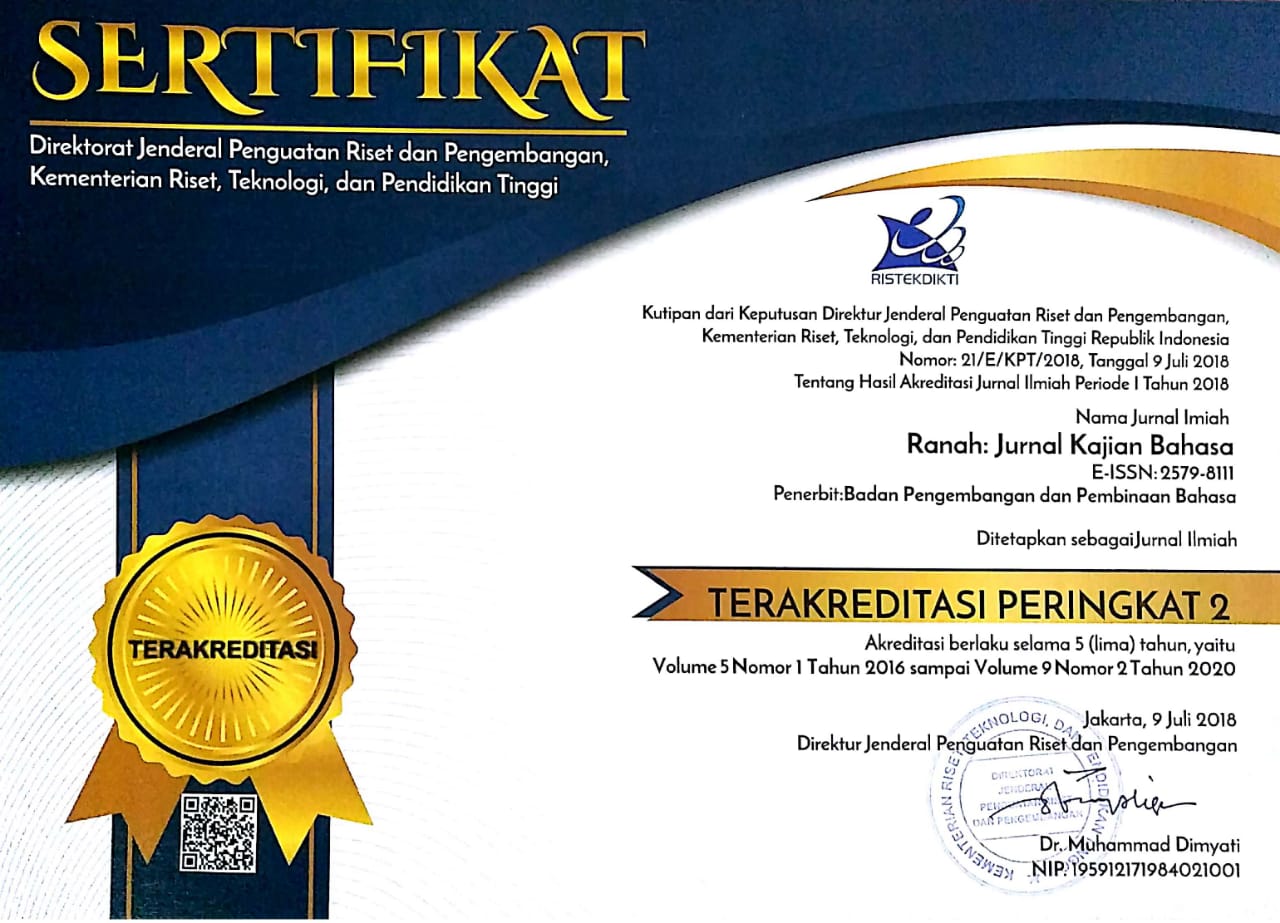Kappa: Makhluk Mitologis Penjaga Sungai dalam Cerita Rakyat Jepang
Abstract
This article discusses one of the Japanese mythological creatures in the youkai category, the kappa which is believed to be river guardians. Data is taken from the anthology of Japanese folklore Mangga Nippon Mukashi Banashi 101 edited by Sayumi Kawauchi. Folklore used as the object of research are two titles that were chosen selectively which are "Kasa Uri Ohana" (Ohana the Umbrella Seller) and "Kappa no Amagoi " (Rain Calling Prayer from Kappa). Data were analyzed with Peirce's semiotic trichotomy theory, namely icons, indices and symbols, and literary anthropological theory. This article concluded three things related to the form of a kappa, where they are believed to be present and the status of kappa in the Japanese belief system. Kappa in Japanese mythology resembles a frog's shape but has scales and has a weakness in its skull. Kappa is believed to live in rivers in Japan. Kappa is present and has a special place in Japanese society's trust, evidenced by the existence of kappa temples. Unlike other Japanese youkai, the kappa is believed that before the form of the kappa he was a god whose rank was demoted, therefore it was believed that he could be begged for rain. The existence of kappa, thus, not only has negative attributes but also positive ones.
Abstrak
Artikel ini mengkaji sosok kappa, salah satu makhluk mitologis dan gaib Jepang yang masuk kategori youkai (hantu) dan dipercaya sebagai makhluk penjaga sungai. Data diambil dari antologi cerita rakyat Jepang Mangga Nippon Mukashi Banashi 101 dengan editor Sayumi Kawauchi. Cerita rakyat yang digunakan sebagai objek penelitian ada dua judul yang dipilih secara selektif, yaitu “Kasa Uri Ohana” (Ohana si Penjual Payung) dan “Kappa no Amagoi” (‘Doa Pemanggil Hujan dari Kappa). Data dianalisis dengan teori trikotomi semiotika Peirce, yaitu ikon, indeks, dan simbol, serta teori antropologi sastra. Artikel ini menyimpulkan tiga hal, yaitu wujud kappa, tempat mereka dipercaya hadir, dan eksistensi kappa dalam sistem kepercayaan Jepang. Kappa dalam mitologi Jepang menyerupai wujud katak, tetapi bersisik dan memiliki kelemahan di tempurung kepalanya. Makhluk gaib ini dipercaya tinggal dan sekaligus menjadi penjaga sungai-sungai di Jepang. Kappa hadir dan memiliki tempat yang khusus dalam kepercayaan masyarakat Jepang, yang dibuktikan dengan terdapatnya kuil kappa. Tidak seperti youkai Jepang lainnya, kappa dipercaya bahwa sebelum berwujud kappa dia adalah dewa yang derajatnya diturunkan. Oleh karena itu, kappa diyakini bisa dimohon untuk mendatangkan hujan. Dengan demikian, eksistensi kappa tidak saja memiliki atribut negatif, tetapi juga positif.
Keywords
Full Text:
PDF (Bahasa Indonesia)References
Aina. (2009). "Mayoke toka Yuurei toka kara Mi o Mamoru tameni Shio o Mi ni Tsuketarisuru janai desuka?" http:detail.chiebukuro.yahoo.co.jp/qa/question_det ail/q1132783166. Diunduh pada tanggal 14 Desember 2019, pukul 12.30 WIB.
Akutagawa, Ryunosuke. (2009). Kappa. London: Peter Owen Publishers.
Ashkenazi, Michael. (2008). Hand Book of Japanese Mythology. New York: Oxford University Press.
Chandler, Daniel. (2007). Semiotics: the Basics. London: Routledge. https://doi.org/10.4324/9780203014936
Foster, Michael Dylan. (1998). "The Metamorphosis of the Kappa Transformation of Folklore to Folklorism in Japan." Asian Folklore Studies, 57 (1), 1-24. https://doi.org/10.2307/1178994
Foster, Michael Dylan. (2015). The Book of Yokai: Mysterious Creatures of Japanese Folklore. California: The Regents of the University of California. https://doi.org/10.2307/1178994
Fujita, Hiroko. (2008). Folktales from the Japanese Country Side (edited by Fran Stallings with Harold Wright and Miki Sakurai). London: Libraries Unlimited.
Kawauchi, Sayumi. (2007). Mangga Nippon Mukashi Banashi 101. Tokyo: Futami Shobou.
Kurosawa, Akio. (2004). Illustrated Martial Arts & Sports in Japan. Tokyo: JTB.
Mizuki, Shigeru dan Murakami Kenji. (2010). Nihon Youkai Daijiten. Tokyo: Kwai Shoten.
Nelson, Andrew N. (2001). Kamus Kanji Modern Jepang Indonesia. Jakarta: Kesaint Blanc.
Ratna, Nyoman Kutha. (2009). Teori, Metode, dan Teknik Penelitian Sastra dari Strukturalisme hingga Poststrukturalisme: Perspektif Wacana Naratif. Yogyakarta: Pustaka Pelajar.
Roberts, Jeremy. (2010). Japanese Mythology A to Z. New York: Chelsea House.
Ross, Catrien. (2007). Mistik Jepang. Terjemahan Tim Kretif. Supernatural and Mysterious Japan. Yogyakarta: Pinus Book Publisher.
Seaton, Philip, Takayoshi Yamamura, Akiko Sugawa-Shimada, dan Kyungjae Jang. (2017). Contents Tourism in Japan Pilgrimages to "Sacred Sites" of Popular Culture. New York: Cambria Press.
Setiowati, Rosa Vania dan Elisa Dwi Wardani. (2016). "Capitalism as an Ideology Criticized through Allegory in Ryūnosuke Akutagawa's Kappa." Journal of Language and Literature (JOLL),16 (2), 178-200. https://doi.org/10.24071/joll.2016.160208
Shimura, Kunihiro. (2008). Zusetsu Chizu to Arasuji de Yomu Nihon no Youkai Densetsu. Tokyo: Seishun.
Sudikan, Setya Yuwana. (2007). Antropologi Sastra. Surabaya: Unesa University Press.
Sudjianto. (2002). Kamus Istilah Masyarakat dan Kebudayaan Jepang. Jakarta: Kesaint Blanc.
Yoda, Hiroko dan Matt Alt. (2008). Yokai Attack!: The Japanese Monster Survival Guide. Tokyo: Kodansha International.
DOI: https://doi.org/10.26499/jentera.v9i1.1956
Refbacks
- There are currently no refbacks.






















